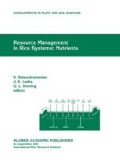Abstract
Although efficient use of N remains a critical constraint to productivity in irrigated lowland rice, a comprehensive database does not exist for the efficiency of on-farm management of N and other nutrients. In 1994, IRRI initiated its Mega Project on Reversing Trends of Declining Productivity in Intensive Irrigated Rice Systems in selected rice production domains of five tropical Asian nations to improve on-farm fertilizer use efficiency and to monitor long-term productivity trends as related to fertilizers and other inputs. Data are reported here for the first crop cycle, the 1994–95 dry season. The indigenous soil N supply (INS) was estimated by aboveground crop N uptake and grain yield (GY) in plots without applied N established in farmers’ fields under otherwise favorable growth conditions. The fertilizer N rate each farmer applied to his/her field surrounding these plots was recorded; GY was also measured in that area. In each domain, GY in unfertilized plots varied considerably among farms, as the range between maximum and minimum values within each domain was at least 2.8 t ha-1, thus of comparable magnitude to mean GY for these plots. Fertilizer N rates varied from 36 to 246 kg ha-1 across all domains, but their lack of relationship to INS contributed to relatively low fertilizer N efficiency and high variability in efficiency among farms. Mean agronomic efficiency (ΔGY/applied N rate) for each domain was only 6–15 kg grain kg-1 N, while values for individual farmers ranged from 0 to 59 kg grain kg-1 N. Initial data on P and K fertilizer management also suggest highly variable applications at suboptimal efficiency. These results indicate the potential for greater fertilizer efficiency from improved congruence between the indigenous soil supply and applied fertilizer and emphasize the need for field-specific nutrient management. Although agronomic efficiency and partial factor productivity (GY/applied N rate) can each be used to describe the efficiency of fertilizer applications, a complete analysis of nutrient management should include both terms, grain yield, fertilizer rates, and native soil fertility.
Access this chapter
Tax calculation will be finalised at checkout
Purchases are for personal use only
Preview
Unable to display preview. Download preview PDF.
References
Appel T (1994) Relevance of soil N mineralization, total N demand of crops and efficiency of applied N for fertilizer recommendations for cereals-theory and application. Z. Pflanzenernähr. Bodenkd. 157:407–414
Cassman K G, Pingali P L (1995) Extrapolating trends from long-term experiments to farmers’ fields: The case of irrigated rice systems in Asia. Pages 63–84 in Barnett V, Payne R, Steiner R (Eds.) Agricultural sustainability: economic, environmental, and statistical considerations. John Wiley & Sons, London
Cassman K G, De Datta S K, Olk D C, Alcantara J, Samson M, Descalsota J, Dizon M (1995) Yield decline and the nitrogen economy of long-term experiments on continuous, irrigated rice systems in the tropics. Pages 181–222 in Lal R, Stewart BA (Eds.) Soil management: experimental basis for sustainability and environmental quality. CRC Press, Boca Raton, FL
Cassman K G, Dobermann A, Sta Cruz P C, Gines G C, Samson M I, Descalsota J P, Alcantara J M, Dizon M A, Olk D C (1996a) Soil organic matter and the indigenous nitrogen supply of intensive irrigated rice systems in the tropics. Plant Soil 182: 267–278.
Cassman K G, Gines G C, Dizon M A, Samson M I, Alcantara J M (1996b) Nitrogen use efficiency in tropical lowland rice systems: contributions from indigenous and applied nitrogen. Fields Crops Res. 47:1–12.
Crasswell E T, Vlek P L G (1979) Fate of fertilizer nitrogen applied to wetland rice. Pages 175–182 in Nitrogen and rice. International Rice Research Institute, P.O. Box 933, Manila, Philippines.
De Datta S K, Buresh R J (1989) Integrated nitrogen management in irrigated rice. Adv. Agron. 10:143–169.
Olk D C, Cassman K G, Randall E W, Kinchesh P, Sanger L J Anderson JM (1996a) Changes in chemical properties of soil organic matter with intensified rice cropping in tropical lowland soils. Eur. J. Soil Sci. 47: 293–303
Olk D C, Cassman K G, Simbahan G, Sta Cruz P C, Abdulrachman S, Nagarajan R, Pham Sy Tan, Satawathananont S. (1996b) Congruence of N fertilizer management by farmers and soil N supply in tropical irrigated lowland rice systems. Pages 29–38 in Maximizing sustainable rice yields through improved soil and environmental management. Proceedings of the Symposium of the Paddy Soil Fertility Working Group, ISSS, Khon Kaen, Thailand.
Peng S, Khush G S Cassman K G (1994) Evolution of the new plant ideotype for increased yield potential. Pages 5–20 in Cassman K G (Ed.) Breaking the yield barrier: proceedings of a workshop on rice yield potential in favorable environments. International Rice Research Institute. P.O. Box 933, Manila, Philippines.
Peng S, Garcia F V, Laza R C, Sanico A L, Visperas R M, Cassman K G (1996) Increased nitrogen use efficiency at high yield levels using a chlorophyll meter. Field Crops Res. 47: 243–252.
Author information
Authors and Affiliations
Editor information
Rights and permissions
Copyright information
© 1999 Springer Science+Business Media Dordrecht
About this chapter
Cite this chapter
Olk, D.C. et al. (1999). Interpreting fertilizer use efficiency in relation to soil nutrient-supplying capacity, factor productivity, and agronomic efficiency. In: Balasubramanian, V., Ladha, J.K., Denning, G.L. (eds) Resource Management in Rice Systems: Nutrients. Developments in Plant and Soil Sciences, vol 81. Springer, Dordrecht. https://doi.org/10.1007/978-94-011-5078-1_3
Download citation
DOI: https://doi.org/10.1007/978-94-011-5078-1_3
Publisher Name: Springer, Dordrecht
Print ISBN: 978-94-010-6133-9
Online ISBN: 978-94-011-5078-1
eBook Packages: Springer Book Archive

